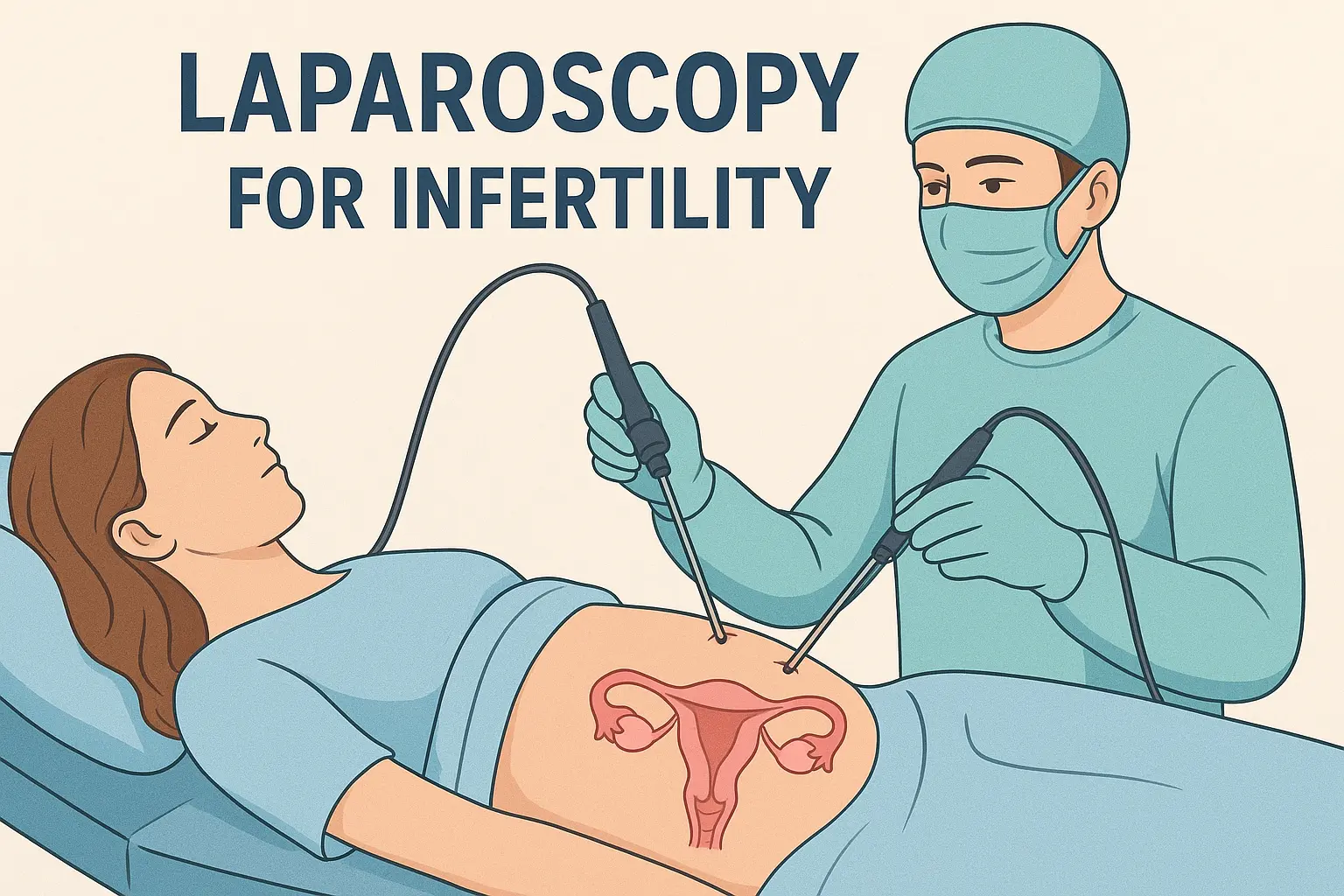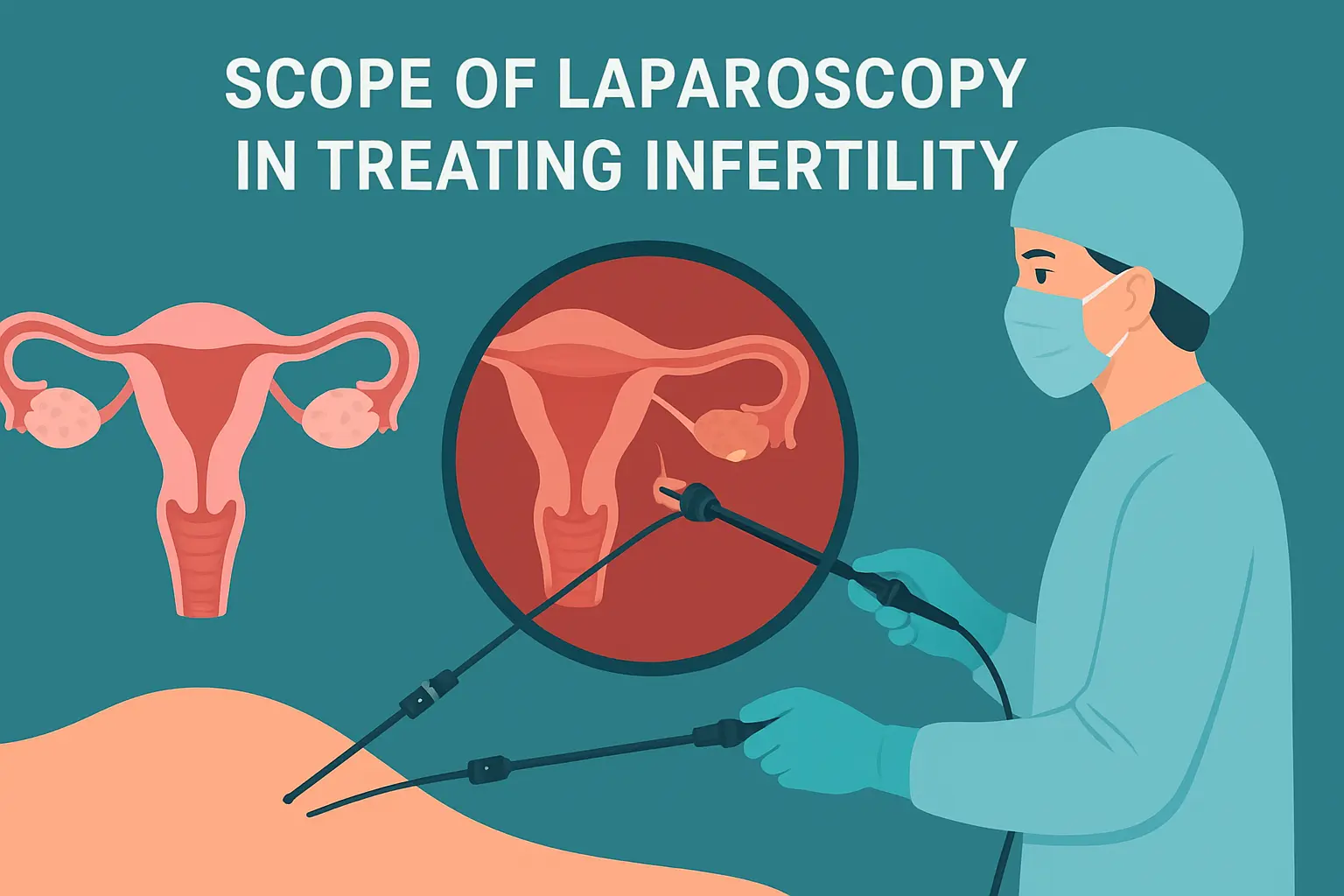Laparoscopy for Infertility Cost: Expert Tips You Need!

Laparoscopy is a surgical procedure used for testing fertility, where the reproductive system, including the ovaries, fallopian tubes, and uterus, is evaluated. It gives a visual inspection of the reproductive organs, identifying issues like endometriosis, fibroids, or blocked fallopian tubes that may not be visible through other tests. Many couples also inquire about the Laparoscopy for Infertility Cost to understand the financial aspects before undergoing the procedure.
In this article, we will be talking about what laparoscopy is for infertility, why it is done, different types of laparoscopy to identify infertility, and, most importantly, the cost of conducting a laparoscopy.
What is Laparoscopy for Infertility?

Laparoscopy for infertility is a minimally invasive surgical procedure in which a tube with a camera, known as a laparoscope, is inserted through a small incision in the abdomen. This gives the doctor a view of the uterus, fallopian tubes, ovaries, and surrounding pelvic area. The cause of infertility, be it a blockage in the fallopian tube, scar tissue, or endometriosis, will be removed with the help of precision instruments through the incisions made.
From gallbladder and appendix removal to endometriosis, hernias, and even certain types of cancers, laparoscopy is used in different scenarios.
Conducting a laparoscopy to identify infertility is considered one of the most reliable diagnostic methods. Laparoscopic surgery often has a positive outcome, with most women getting pregnant within months after the surgery.
Why Laparoscopy is Done in Infertility
Laparoscopy is used to diagnose and treat the root causes of infertility, such as blocked fallopian tubes, endometriosis, pelvic adhesions, and fibroids, that are not usually identified in standard tests.
Laparoscopy offers direct visualization, which helps in identifying even subtle issues like mild endometriosis, scar tissue formations in the pelvic area, abnormalities, and blockages in the tube, and minor anatomical distortions in the size and shape of the ovaries and uterus.
Laparoscopic treatment identifies the problem during the procedure and provides treatment on the spot by removing the endometriotic lesions, addressing the issues. In cases where immediate treatment is not possible, the images and information gathered can offer guidance to future treatment plans.
Types of Laparoscopy in Infertility Treatment
Different types of laparoscopic surgeries are conducted for treating infertility, such as:
- Diagnostic Laparoscopy: This technique helps in diagnosing various conditions in the abdominal and pelvic area, including unexplained infertility, endometriosis, chronic pain in the pelvis, and certain infections.
- Laparoscopic Hysterectomy: Used to treat conditions like fibroids, excessive bleeding, or even uterine cancers, a laparoscopic hysterectomy is a minimally invasive surgery that removes the uterus. Depending on the condition, the uterus will be completely or partially removed.
- Laparoscopic Ovarian Cystectomy: Removal of an ovarian cyst while keeping the ovary intact. Ovarian cystectomy is helpful for women suffering from severe pain, irregular periods, or fertility issues caused by cysts.
- Laparoscopic Myomectomy: Women having fibroids who wish to conceive in the future undergo laparoscopic myomectomy, in which the uterus is preserved while removing fibroids. The fibroids will be cut into small pieces and removed without damaging the uterus.
- Laparoscopic Endometriosis Surgery: A primary cause of infertility among women, endometriosis causes severe pelvic pain. The surgery can remove endometrial tissue growing outside the uterus, while the reproductive organs are preserved.
Based on the type of infertility treatment being carried out, the total cost may vary for the laparoscopic surgery.
Cost of Laparoscopy for Infertility
The cost of laparoscopy procedures for infertility treatment can range from Rs.20000 to over Rs.130000. However, this may vary based on the hospital, the doctor’s expertise, and even the location of the hospital.
The cost also depends on the type of laparoscopy being done, that is, operative or diagnostic laparoscopy. Diagnostic laparoscopy is an exploratory procedure, while an operative laparoscopy is basically a surgical treatment. Operative laparoscopy tends to be costlier than diagnostic laparoscopy due to its complexity, longer time, and use of additional surgical tools and equipment.
The cost for laparoscopic treatment for infertility also includes the surgeon’s fee, anesthesia expenses, the extent of hospital stay, various lab tests conducted, pre- and post-operative care, and treatment.
Make sure that you contact your insurance provider to know if they cover laparoscopy for infertility, what your out-of-pocket costs will be, etc.. In case you don’t have insurance or your insurance doesn’t cover laparoscopic surgery, you can compare the price ranges from different hospitals before finalizing your surgery.
Factors Affecting Laparoscopy for Infertility Cost
The cost of laparoscopy depends on various factors, including:
- Type of surgery being performed: Laparoscopy for diagnostics is less expensive than surgical laparoscopy, especially for complex procedures like removing large fibroids or tubal reversal.
- Facilities being provided at the hospital: The cost also depends on the location of the hospital, as well as the facilities provided. Hospitals in major metropolitan areas tend to be more expensive than other hospitals.
- Expertise of the surgeon: Experienced surgeons generally have higher fees due to their expertise, knowledge, and higher quality of care.
- Preoperative and postoperative care: The additional care and tests conducted before and after the surgery can add to the total cost of laparoscopy surgery.
- Medications and anesthesia: Different situations require different medications, which require additional cost.
- Length of the hospital stay: In some cases, laparoscopic patients might require admission to the hospital, which will add to the overall bill. Also, the type of room chosen will impact the cost.
What to Expect Before, During, and After the Procedure
Knowing about what happens before, after, and during surgery is important to make an informed decision.
- Before Laparoscopy Surgery
Once the consulting surgeon fixes the surgery, he will assess your health history, symptoms, etc. Depending on the procedure, you might be asked to fast for a certain period of time and pause any medication. Preoperative tests like blood tests, electrocardiograms (ECG), and imaging will be suggested.
- During Laparoscopy Surgery
In most cases of laparoscopy surgery for infertility, general anesthesia is given to the patient. Small incisions in the abdominal area, typically around 0.5 and 1.5 centimeters, are made, through which the laparoscope is inserted to get a real-time imaging on the monitor.
Depending on the goal of the procedure, different operations such as biopsy of the tissues, cyst and tumor removal, or abdominal organ repair might be performed. After the surgery, the surgical tools are removed, and the incision is sewn with adhesive strips or stitches.
- After Laparoscopy Surgery
Once the incision is closed and you are out of anesthesia, your vitals will be monitored by the surgeon. Painkillers or other medications and a diet plan will be prescribed for faster recovery. You may be asked to visit the hospital for follow-up appointments to monitor your recovery and healing.
Benefits of Laparoscopy in Infertility Management
The advantages of opting for a laparoscopic surgery rather than traditional surgery methods are:
- A less invasive treatment option for issues like fibroids, ovarian cysts, or blockages in the fallopian tube.
- Quicker recovery time, lesser pain, and minimal scarring.
- Increased chances of natural conception or improved success rate of ART.
- Accurate, high-definition, real-time visualization of the pelvic organs.
- Reveals even mild endometriosis or pelvic adhesions that often go unnoticed.
- Diagnosis and treatment can be carried out in a single procedure.
- Corrects blocked tubes or scarred fallopian tubes, which hinder natural conception.
- Lower risks or complications.
Risks and Limitations
Though not severe, the risks posed by laparoscopy surgery for infertility are:
- Internal bleeding.
- Infections.
- Minor damage to the internal organs.
- Improper healing at the location of the incision.
- Risks associated with anesthesia.
- Recurrence of the symptoms of infertility.
Conclusion
Laparoscopy is a highly favored treatment method for infertility in women. Compared to the traditional infertility treatments, laparoscopic surgery is highly beneficial with very few risks. The cost of laparoscopy can be anywhere between, depending on various factors like the hospital chosen, the type of procedure, etc.
Frequently Asked Questions
Laparoscopic surgeries are generally more expensive due to the specialized equipment used.
While diagnostic laparoscopy may not need to include a surgical laparoscopy, a surgical laparoscopy is preceded by a diagnostic laparoscopy.
Most women undergoing laparoscopic surgery may be able to resume a normal life within one to three weeks after surgery.
Laparoscopic surgery is performed when other treatment procedures fail to restore fertility, and is generally successful in most cases.
Almost 60% of infertile women who have undergone a laparoscopic surgery are able to conceive after 3 months of the surgery.
